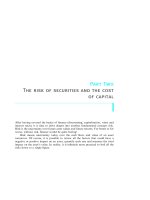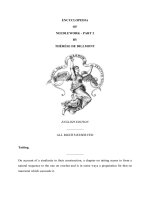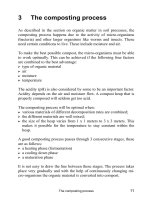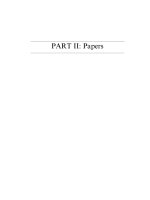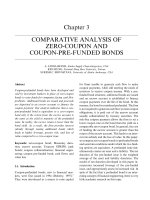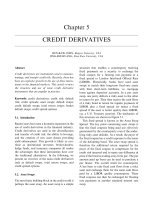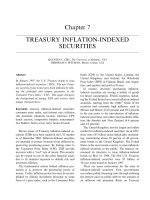Encyclopedia of Finance Part 2 pps
Bạn đang xem bản rút gọn của tài liệu. Xem và tải ngay bản đầy đủ của tài liệu tại đây (425.87 KB, 16 trang )
PART II: Papers
Chapter 1
DEPOSIT INSURANCE SCHEMES
JAMES R. BARTH, Auburn University and Milken Institute, USA
CINDY LEE, China Trust Bank, USA
TRIPHON PHUMIWASANA, Milken Institute, USA
Abstract
More than two-thirds of member countries of the
International Monetary Fund (IMF) have experi-
enced one or more banking crises in recent years.
The inherent fragility of banks has motivated about
50 percent of the countries in the world to establish
deposit insurance schemes. By increasing depositor
confidence, deposit insurance has the potential to
provide for a more stable banking system. Although
deposit insurance increases depositor confidence, it
removes depositor discipline. Banks are thus freer to
engage in activities that are riskier than would other-
wise be the case. Deposit insurance itself, in other
words, could be the cause of a crisis. The types of
schemes countries have adopted will be assessed as
well as the benefits and costs of these schemes in
promoting stability in the banking sector.
Keywords: deposit insurance; banks; regulation,
banking crisis; bank runs; banking instability; de-
positor discipline; moral hazard; bank supervision;
financial systems
1.1. Introduction
During the last three decades of the 20th century,
more than two-thirds of member countries of the
International Monetary Fund (IMF) have experi-
enced one or more banking crises. These crises
occurred in countries at all levels of income and
in all parts of the world. This troublesome situ-
ation amply demonstrates that while banks are
important for channeling savings to productive
investment projects, they nonetheless remain rela-
tively fragile institutions. And when a country’s
banking system experiences systemic difficulties,
the results can be disruptive and costly for the
whole economy. Indeed, the banking crises that
struck many Southeast Asian countries in mid-
1997 cost Indonesia alone more than 50 percent
of its Gross Domestic Product (GDP).
The inherent fragility of banks has motivated
many nations to establish deposit insurance
schemes. The purpose of such schemes is to assure
depositors that their funds are safe by having the
government guarantee that these can always be
withdrawn at full value. To the extent that deposi-
tors believe that the government will be willing and
able to keep its promise, they will have no incentive
to engage in widespread bank runs to withdraw
their funds. By increasing depositor confidence in
this particular way, deposit insurance thus has the
potential to provide for a more stable banking
system.
Although deposit insurance increases depositor
confidence, however, it gives rise to what is re-
ferred to as ‘‘moral hazard’’ (Gropp and Vesala,
2001). This is a potentially serious problem, which
arises when depositors believe their funds are safe.
In such a situation they have little, if any, incentive
to monitor and police the activities of banks. When
this type of depositor discipline is removed because
of deposit insurance, banks are freer to engage in
activities that are riskier than would otherwise be
the case. To the extent that this type of moral
hazard is not kept in check by the bank regulatory
and supervisory authorities after a country estab-
lishes a deposit insurance scheme, its banking sys-
tem may still be susceptible to a crisis. Deposit
insurance itself, in other words, could be the
cause of a crisis (Cooper and Ross, 2002; Diamond
and Dybvig, 2000).
The establishment of a deposit insurance scheme
therefore is not a sinecure. It provides both poten-
tial benefits and costs to a society. The difficult issue
is maximizing the benefits while simultaneously
minimizing the costs. It is for this reason that gov-
ernments and citizens in countries around the globe
need a better appreciation and understanding of
deposit insurance. This is particularly the case inso-
far as ever more countries have been establishing
such schemes in recent years. Indeed, since the first
national deposit insurance scheme was established
by the United States in 1933 (Bradley, 2000), nearly
70 more countries have done so, most within the
past 20 years. The IMF, moreover, suggests that
every country should establish one (Garcia, 2000).
1.2. The Inherent Fragility of Banks
It is a well known and widely accepted fact
that banks are an important part of a nation’s
financial system. They complement the nonbank
financial institutions and the capital markets in
promoting economic growth and development. In
particular, banks extend credit to business firms for
various investment projects and otherwise assist
them in coping with various types of financial risk.
They also facilitate the payment for goods and ser-
vices by providing a medium of exchange in the
form of demand deposits. But in providing these
services, banks create longer-term assets (credit)
funded with shorter-term liabilities (deposits).
Therein lies the inherent source of bank fragility.
Depositors may decide to withdraw their deposits
from banks at any time.
The worst-case scenario is one in which deposi-
tors nationwide become so nervous about the
safety of their deposits that they simultaneously
decide to withdraw their deposits from the entire
banking system. Such a systemic run would force
banks to liquidate their assets to meet the with-
drawals. A massive sale of relatively opaque assets,
in turn, would require that they be sold at ‘‘fire-
sale’’ prices to obtain the needed cash. This situ-
ation could force illiquid but otherwise solvent
institutions into insolvency.
The typical structure of a bank’s balance sheet is
therefore necessarily fragile. Any bank would be
driven into insolvency if its assets had to be imme-
diately sold to meet massive withdrawals by its
depositors. This would not be a concern if such
an event were a mere theoretical curiosity. There
have in fact been widespread bank runs in various
countries at various points in time. There have
even been instances where bank runs in one coun-
try have spread beyond its borders to banks in
other countries. Unfortunately, bank runs are not
benign. They are destructive insofar as they disrupt
both the credit system and the payments mechan-
ism in a country. Worse yet, the bigger the role
banks play in the overall financial system of a
country, the more destructive a banking crisis will
be on economic and social welfare. This is typically
the situation in developing countries.
1.3. The Benefits of Deposit Insurance Schemes
The primary purpose of a deposit insurance
scheme is to minimize, if not entirely eliminate,
the likelihood of bank runs. A secondary purpose
is to protect small depositors from losses. At
the time of the Great Depression in the Unites
States, banks had experienced widespread runs
and suffered substantial losses on asset sales in an
attempt to meet deposit withdrawals. The situation
was so devastating for banks that President Roo-
sevelt declared a bank holiday. When banks were
re-opened, they did so with their deposits insured
by the federal government. This enabled depositors
to be confident that their funds were now indeed
safe, and therefore there was no need to withdraw
them. This action by the government was sufficient
300 ENCYCLOPEDIA OF FINANCE
to restore confidence in depositors that their funds
were safe in banks. By establishing a ‘‘safety net’’
for depositors of banks, bank runs were eliminated
in the United States.
Before the establishment of deposit insurance in
the United States, it was the responsibility of the
Federal Reserve System to prevent bank runs. This
goal was supposed to be accomplished by lending
funds to those banks which were experiencing
liquidity problems and not solvency problems. In
other words, the Federal Reserve System was sup-
posed to be a lender of the last resort, always ready
to lend to illiquid but solvent banks, when nobody
else was willing to do so. Yet, it did not fulfill its
responsibility during the 1930s. It was therefore
considered necessary to establish an explicit de-
posit insurance scheme to reassure depositors that
their deposits would always be safe and readily
available on demand. Deposit insurance thus be-
came a first line of defense against bank runs.
For nearly 50 years after its establishment, the
U.S. deposit insurance scheme worked as intended.
There were no bank runs and the consensus was
that deposit insurance was a tremendous success.
But then events occurred that called this view into
question. Savings and loans, which had also been
provided with their own deposit insurance scheme
at the same time as banks, were devastated by
interest rate problems at first, and then by asset
quality problems during the 1980s. The savings
and loan problems were so severe that even their
deposit insurance fund became insolvent during
the mid-1980s. Ultimately, taxpayers were required
to contribute the majority of the $155 billion, the
cost for cleaning up the mess. Fortunately, even
though the deposit insurance fund for banks be-
came insolvent during the late 1980s, the cleanup
cost was only about $40 billion. And taxpayers
were not required to contribute to covering this
cost.
The fact that several thousand depository insti-
tutions – in this case both savings and loans, and
banks – could fail, and cost so much to resolve
convincingly demonstrated to everyone that de-
posit insurance was not a panacea for solving
banking problems. Despite being capable of ad-
dressing the inherent fragility problem of banks,
deposit insurance gave rise to another serious
problem, namely, moral hazard.
1.4. The Costs of Deposit Insurance Schemes
While instilling confidence in depositors that their
funds are always safe, so as to prevent bank runs,
deposit insurance simultaneously increases the
likelihood of another serious banking problem in
the form of moral hazard. By removing all con-
cerns that depositors have over the safety of their
funds, deposit insurance also removes any incen-
tive depositors have to monitor and police the
activities of banks. Regardless of the riskiness of
the assets that are acquired with their deposits,
depositors are assured that any associated losses
will be borne by the deposit insurance fund, and
not by them. This situation therefore requires that
somebody else must impose discipline on banks. In
other words, the bank regulatory and supervisory
authorities must now play the role formerly played
by depositors.
There is widespread agreement that regulation
and supervision are particularly important to pre-
vent banking problems once countries have estab-
lished a deposit insurance scheme. Countries doing
so must more than ever contain the incentive for
banks to engage in excessively risky activities once
they have access to deposits insured by the govern-
ment. The difficult task, however, is to replace the
discipline of the private sector with that of the
government. Nonetheless, it must and has been
done with varying degrees of success in countries
around the world. The proper way to do so in-
volves both prudential regulations and effective
supervisory practices.
Skilled supervisors and appropriate regulations
can help prevent banks from taking on undue risk,
and thereby exposing the insurance fund to exces-
sive losses. At the same time, however, banks must
not be so tightly regulated and supervised that they
are prevented from adapting to a changing finan-
cial marketplace. If this happens, banks will be less
DEPOSIT INSURANCE SCHEMES 301
able to compete and thus more likely to fail. The
regulatory and supervisory authorities must there-
fore strike an appropriate balance between being
too lenient and too restrictive, so as to promote a
safe and sound banking industry.
The appropriateness of specific regulations and
supervisory practices necessarily depends upon the
specific design features of a deposit insurance
scheme. Some features may exacerbate moral haz-
ard, whereas others may minimize it. In other
words, it is important for a government to realize
that when designing a scheme, one must take into
account the effects the various features will have
on both depositor confidence and moral hazard. In
this regard, information has recently become avail-
able describing many of the important differences
among deposit insurance schemes that have been
established in a large number of countries. It is,
therefore, useful to examine this ‘‘menu of deposit
insurance schemes’’. One can thereby appreciate
the ways in which these schemes differ, and then
try to assess which combination of features seems
to strike a good balance between instilling depos-
itor confidence so as to eliminate bank runs and
yet containing the resulting moral hazard that
arises when depositor discipline is substantially, if
not entirely, eliminated.
1.5. Differences in Deposit Insurance Schemes
Across Countries
Of the approximately 220 countries in the
world, about half of them have already estab-
lished or plans to establish deposit insurance
schemes. Information on selected design features
for the schemes in 68 countries is presented in
Table 1.1. It is quite clear from this information
that there are important differences in key features
across all these countries, which includes both
emerging market economies and mature economies
(Demirgu
¨
c¸-Kunt and Kane, 2002; Demirgu
¨
c¸-Kunt
and Sobaci, 2001; Demirgu
¨
c¸-Kunt and Detra-
giache, 2000; Garcia, 1999). At the outset it should
be noted that the vast majority of these countries
have only recently established deposit insurance
for banks. Indeed, 50 of the 68 countries have
established their schemes within the past 20 years.
And 32 of these countries established them within
the past decade. More countries are either in the
process or likely in the near future to establish a
deposit insurance scheme. Differences in each of
the other important features noted in the table will
now be briefly described in turn.
One key feature of any deposit insurance scheme
is the coverage limit for insured depositors. The
higher the limit the more protection is afforded to
individual depositors, but the higher the limit the
greater the moral hazard. The limits vary quite
widely for countries, ranging from a low of $183
in Macedonia to a high of $260,800 in Norway.
For purposes of comparison, the limit is $100,000
in the United States. One problem with these com-
parisons, however, is that there are wide differ-
ences in the level of per capita income among
these countries. It is therefore useful to compare
the coverage limits after expressing them as a ratio
to GDP per capita. Doing so one finds that Chad
has the highest ratio at 15, whereas most of the
other countries have a ratio at or close to 1.
Clearly, ratios that are high multiples of per capita
GDP are virtually certain to eliminate any discip-
line that depositors might have otherwise imposed
on banks.
Apart from coverage limits, countries also differ
with respect to coinsurance, which may or may not
be a part of the deposit insurance scheme. This
particular feature, when present, means that de-
positors are responsible for a percentage of any
losses should a bank fail. Only 17 of the 68 coun-
tries have such a feature. Yet, to the extent that
depositors bear a portion of any losses resulting
from a bank’s failure, they have an incentive to
monitor and police banks. Usually, even when
countries adopt coinsurance, the percentage of
losses borne by depositors is capped at 10 percent.
Even this relatively small percentage, however, is
enough to attract the attention of depositors when
compared to the return they can expect to earn on
their deposits, and thereby help to curb moral
hazard.
302 ENCYCLOPEDIA OF FINANCE
Table 1.1. Design features of deposit insurance schemes in countries around the world
Countries
Date
enacted=
revised
Coverage
limit
Coverage
ratio limit=
GDP per
capita Coinsurance
Type of fund
(Yes ¼ funded;
No ¼ unfunded)
Risk-adjusted
Premiums
Type of
membership
Argentina 1979=1995 $30,000 3 No Yes Yes Compulsory
Austria 1979=1996 $24,075 1 Yes No No Compulsory
Bahrain 1993 $5,640 1 No No No Compulsory
Bangladesh 1984 $2,123 6 No Yes No Compulsory
Belgium 1974=1995 $16,439 1 No Yes No Compulsory
Brazil 1995 $17,000 4 No Yes No Compulsory
Bulgaria 1995 $1,784 1 No Yes Yes Compulsory
Cameroon 1999 $5,336 9 No Yes Yes Voluntary
Canada 1967 $40,770 2 No Yes No Compulsory
Central
African
Republic
1999 $3,557 13 No Yes Yes Voluntary
Chad 1999 $3,557 15 No Yes Yes Voluntary
Chile 1986 $3,600 1 Yes No No Compulsory
Colombia 1985 $5,500 2 Yes Yes No Compulsory
Croatia 1997 $15,300 3 No Yes No Compulsory
Czech
Republic
1994 $11,756 2 Yes Yes No Compulsory
Denmark 1988=1998 $21,918 1 No Yes No Compulsory
Dominican
Republic
1962 $13,000 7 Yes Yes No Voluntary
Ecuador 1999 N=AN=A No Yes No Compulsory
El Salvador 1999 $4,720 2 No Yes Yes Compulsory
Equatorial
Guinea
1999 $3,557 3 No Yes Yes Voluntary
Estonia 1998 $1,383 0 Yes Yes No Compulsory
Finland 1969=1992=1998 $29,435 1 No Yes Yes Compulsory
France 1980=1995 $65,387 3 No No No Compulsory
Gabon 1999 $5,336 1 No Yes Yes Voluntary
Germany 1966=1969=1998 $21,918 1 Yes Yes No Compulsory
Gibraltar 1998 N=A Yes No No Compulsory
Greece 1993=1995 $21,918 2 No Yes No Compulsory
Hungary 1993 $4,564 1 No Yes Yes Compulsory
Iceland 1985=1996 $21,918 1 Yes Yes No Compulsory
India 1961 $2,355 6 No Yes No Compulsory
Ireland 1989=1995 $16,439 1 Yes Yes No Compulsory
Italy 1987=1996 $125,000 6 No No Yes Compulsory
Jamaica 1998 $5,512 2 No Yes No Compulsory
Japan 1971 N=AN=A No Yes No Compulsory
Kenya 1985 $1,757 5 No Yes No Compulsory
Korea 1996 N=AN=A No Yes No Compulsory
Latvia 1998 $830 0 No Yes No Compulsory
Lebanon 1967 $3,300 1 No Yes No Compulsory
Lithuania 1996 $6,250 2 Yes Yes No Compulsory
(Continued )
DEPOSIT INSURANCE SCHEMES 303
Some countries have elected to establish an ex-
ante funded scheme, whereas others have chosen to
provide the funds for any losses from bank failures
ex-post. Of the 68 countries, only 10 have chosen to
establish an ex-post or unfunded scheme. In this
case, the funds necessary to resolve bank failures
are obtained only after bank failures occur. This
type of arrangement may provide a greater incen-
tive for private monitoring and policing, because
everyone will know that the funds necessary to
Table 1.1. Design features of deposit insurance schemes in countries around the world (Continued )
Countries
Date
enacted=
revised
Coverage
limit
Coverage
ratio limit=
GDP per
capita Coinsurance
Type of fund
(Yes ¼ funded;
No ¼ unfunded)
Risk-adjusted
Premiums
Type of
membership
Luxembourg 1989 $16,439 0 Yes No No Compulsory
Macedonia 1996 $183 0 Yes Yes Yes Voluntary
Marshall
Islands
1975 $100,000 N=A No Yes Yes Voluntary
Mexico 1986=1990 N=AN=A No Yes No Compulsory
Micronesia 1963 $100,000 N=A No Yes Yes Voluntary
Netherlands 1979=1995 $21,918 1 No No No Compulsory
Nigeria 1988=1989 $588 2 No Yes No Compulsory
Norway 1961=1997 $260,800 8 No Yes No Compulsory
Oman 1995 $52,630 9 Yes Yes No Compulsory
Peru 1992 $21,160 9 No Yes Yes Compulsory
Philippines 1963 $2,375 3 No Yes No Compulsory
Poland 1995 $1,096 0 Yes Yes No Compulsory
Portugal 1992=1995 $16,439 1 Yes Yes Yes Compulsory
Republic
of Congo
1999 $3,557 5 No Yes Yes Voluntary
Romania 1996 $3,600 2 No Yes Yes Compulsory
Slovak
Republic
1996 $7,900 2 No Yes No Compulsory
Spain 1977=1996 $16,439 1 No Yes No Compulsory
Sri Lanka 1987 $1,470 2 No Yes No Voluntary
Sweden 1996 $31,412 1 No Yes Yes Compulsory
Switzerland 1984=1993 $19,700 1 No No No Voluntary
Taiwan 1985 $38,500 3 No Yes No Voluntary
Tanzania 1994 $376 2 No Yes No Compulsory
Trinidad &
Tobago
1986 $7,957 2 No Yes No Compulsory
Turkey 1983 N=AN=A No Yes Yes Compulsory
Uganda 1994 $2,310 8 No Yes No Compulsory
Ukraine 1998 $250 0 No Yes No Compulsory
United
Kingdom
1982=1995 $33,333 1 Yes No No Compulsory
United States 1934=1991 $100,000 3 No Yes Yes Compulsory
Venezuela 1985 $7,309 2 No Yes No Compulsory
Source: Demirgu
¨
c¸-Kunt, A. and Sobaci, T. (2001) ‘Deposit Insurance Around the World’, The World Bank Economic Review,
15(3): 481–490. Full database available at http:==econ.worldbank.org=programs=finance=topic=depinsurance=
304 ENCYCLOPEDIA OF FINANCE
resolve problems have not yet been collected. And
everyone will also know that a way to keep any
funds from being collected is to prevent banks
from engaging in excessively risky activities. Of
course, the degree of monitoring depends import-
antly on the source of funding. In this regard, there
are three alternative arrangements: (1) public fund-
ing, (2) private funding, or (3) joint funding. Of
these three sources, private funding provides the
greatest incentive for private discipline and public
funding the least. Although the information is not
provided in the table, only 15 of the 68 countries
fund their deposit insurance schemes solely on the
basis of private sources. At the same time, how-
ever, only one country relies solely on public fund-
ing. Eleven of the schemes that are privately
funded, moreover, are also either privately or
jointly administered. No country, where there is
only private funding, has decided to have the
fund solely administered by government officials.
In addition to the design features already dis-
cussed, there are two other important features that
must be decided upon when a country establishes a
deposit insurance scheme. One is whether in those
countries in which premiums are paid by banks for
deposit insurance should be risk-based or not (Pre-
scott, 2002). The advantage of risk-based premiums
is that they potentially can be used to induce banks
to avoid engaging in excessively risky activities.
This would enable the banking authorities to have
an additional tool to contain moral hazard. Yet, in
practice it is extremely difficult to set and adminis-
ter such a premium structure. Table 1.1 shows that
slightly less than one-third of the countries have
chosen to adopt risk-based premiums.
The last feature to be discussed is the member-
ship structure of a deposit insurance scheme. A
country has to decide whether banks may volun-
tarily join or will be required to join. A voluntary
scheme will certainly attract all the weak banks.
The healthy banks, in contrast, are unlikely to
perceive any benefits from membership. If this
happens, the funding for resolving problems will
be questionable for both ex-ante and ex-post
schemes. Indeed, the entire scheme may simply
become a government bailout for weak banks. By
requiring all banks to become members, the fund-
ing base is broader and more reliable. At the same
time, when the healthy banks are members, they
have a greater incentive to monitor and police the
weaker banks to help protect the fund.
1.6. Lessons Learned from Banking Crises
It is quite clear that although many countries at all
levels of income and in all parts of the world have
established deposit insurance schemes they have
not chosen a uniform structure. The specific design
features differ widely among the 68 countries for
which information is available as already discussed
and indicated in Table 1.1. The fact that so many
countries around the globe have suffered banking
crises over the past 20 years has generated a sub-
stantial amount of research focusing on the rela-
tionship between a banking crisis and deposit
insurance. Although this type of research is still
ongoing, there are currently enough studies from
which to draw some, albeit tentative, conclusions
about deposit insurance schemes that help pro-
mote a safe and sound banking industry. These
are as follows:
. Even without a deposit insurance scheme,
countries have on occasion responded to bank-
ing crises with unlimited guarantees to deposi-
tors. An appropriately designed scheme that
includes a coverage limit may be better able to
serve notice to depositors as to the extent of
their protection, and thereby enable govern-
ments to avoid more costly ex-post bailouts.
. The design features of a deposit insurance
scheme are quite important. Indeed, recent em-
pirical studies show that poorly designed
schemes increase the likelihood that a country
will experience a banking crisis.
. Properly designed deposit insurance schemes
can help mobilize savings in a country, and
thereby help foster overall financial develop-
ment. Research has documented this important
linkage, but emphasizes that it only holds in
DEPOSIT INSURANCE SCHEMES 305
countries with a strong legal and regulatory
environment.
. Empirical research shows that market discip-
line is seriously eroded in countries that have
designed their deposit insurance schemes with a
high coverage limit – an ex-ante fund – the
government being the sole source of funds,
and only public officials as the administrators
of the fund.
. Empirical research shows that market discip-
line is significantly enhanced in countries that
have designed their deposit insurance schemes
with coinsurance, mandatory membership, and
private or joint administration of the fund.
All in all, empirical research that has recently
been completed indicates that governments should
pay close attention to the features they wish to
include in a deposit insurance scheme should they
decide to adopt one, or to modify the one they
have already established (Barth et al., 2006).
1.7. Conclusions
Countries everywhere have shown a greater inter-
est in establishing deposit insurance schemes in the
past two decades. The evidence to date indicates
that much more consideration must be given to the
design features of these schemes to be sure that
their benefits are not offset by their associated
costs.
REFERENCES
Barth, J.R., Caprio, G., and Levine, R. (2006). Rethink-
ing Bank Regulation and Supervision: Till Angels Gov-
ern. Cambridge: Cambridge University Press.
Bradley, C.M. (2000). ‘‘A historical perspect ive on de-
posit insurance coverage’’ FDIC-Banking Review,
13(2): 1–25.
Cooper, R. and Ross, T.W. (2002). ‘‘Bank runs: De-
posit insurance and capital requirements.’’ Inter-
national Economic Review, 43(1): 55–72.
Demirgu
¨
c¸-Kunt, A. and Kane, E.J. (2002). ‘‘Deposit
insurance around the globe: Where does it work?’’
Journal of Economic Perspectives, 16(2): 178–195.
Demirgu
¨
c¸-Kunt, A. and Sobaci, T. (2001). ‘‘Deposit
insurance around the world.’’ The World Bank Eco-
nomic Review, 15(3): 481–490.
Demirgu
¨
c¸-Kunt, A. and Detragiache, E. (2000). ‘‘Does
deposit insurance increase banking system stability?’’
International Monetary Fund Working Paper
WP=00=03.
Diamond, D.W. and Dybvig, P.H. (2000). ‘‘Bank runs,
deposit insurance, and liquidity.’’ Federal Reserve
Bank of Minneapolis Quarterly Review, 24(1): 14–23.
Garcia, G. (2000). ‘‘Deposit insurance and crisis manage-
ment.’’ International Monetary Fund Policy Working
Paper WP=00=57.
Garcia, G. (1999). ‘‘Deposit insura nce: A survey of
actual and best practices.’’ International Monetary
Fund Policy Working Paper WP=99=54.
Gropp, R. and Vesala, J. (2001). ‘‘Deposit insurance
and moral hazard: Does the counterfactual matter?’’
European Central Bank Working Paper No. 47.
Prescott, E.S. (2002). ‘‘Can risk-based deposit insuranc e
premiums control moral hazard?’’ Federal Reserve
Bank of Richmond Economic Quarterly, 88(2): 87–100.
306 ENCYCLOPEDIA OF FINANCE
Chapter 2
GRAMM-LEACH-BLILEY ACT:
CREATING A NEW BANK FOR A NEW
MILLENIUM
JAMES R. BARTH, Auburn University and Milken Institute, USA
JOHN S. JAHERA, Auburn University, USA
Abstract
The Gramm-Leach-Bliley Act (GLBA) was signed
into law on November 12, 1999 and essentially
repealed the Glass-Steagall Act (GSA) of 1933
that had mandated the separation of commercial
banking activities from securities activities. It also
repealed provisions of the Bank Holding Company
Act (BHCA) of 1956 that provided for the separ-
ation of commercial banking from insurance activ-
ities. The major thrust of the new law, therefore,
is the establishment of a legal structure that
allows for the integration of banking, securities and
insurance activities within a single organization.
The GLBA will be explained and discussed, with
special emphasis on its importance for U.S. banks
in a world of ever increasing globalization of finan-
cial services.
Keywords: banking laws; bank regulations; secur-
ities; insurance; financial modernization; financial
holding companies; Glass-Steagall; globalization;
thrifts
2.1. Introduction
The Gramm-Leach-Bliley Act (GLBA) was signed
into law on November 12, 1999 and provided for
sweeping changes in the allowable activities of
banks in the United States (Barth et al., 2000).
The GLBA, also known as the Financial Modern-
ization Act, essentially repealed the Glass-Steagall
Act (GSA) of 1933 that had mandated the separ-
ation of commercial banking activities from secur-
ities activities. In addition, the GLBA repealed
provisions of the Bank Holding Company Act
(BHCA) of 1956 that provided for the separation
of commercial banking from insurance activities.
While the GLBA formally changed the face of
banking, in recent years the regulatory environ-
ment had been evolving away from a stringent
interpretation of the GSA.
The major thrust of the new law is the establish-
ment of a legal structure that allows for the inte-
gration of banking, securities, and insurance
activities within a single organization. The GSA
was enacted during the Great Depression follow-
ing the market crash of 1929. The intent was to
provide for the separation of banking activities
from securities activities based on the view that
undue speculation and conflicts of interest had, at
least in part, led to the market crash and the sub-
sequent failure of numerous banks. As much as
anything, the GSA was supposed to restore confi-
dence in the banking system and securities mar-
kets. However, its restrictive provisions eroded
gradually over the years, and more rapidly in the
past 20 years. In fact, many view the enactment of
the GLBA as merely serving to formalize what had
already been happening de facto in the financial
marketplace, as the distinction between different
types of financial service firms and their products
had become quite blurred.
A particularly important reason to understand
the GLBA at this time is globalization. Banks in
the United States have operated for decades under
some of the most restrictive regulations when com-
pared to banks in most of the other industrial
countries around the world. While the GLBA im-
proves the position of banks in terms of global
competitiveness, U.S. banks still do not enjoy the
same degree of freedom with respect to activities
and organizational structure as banks in many
other countries.
2.2. Major Provisions of Gramm-Leach-Bliley Act
2.2.1. Financial Holding Companies
The GSA and the BHCA restricted bank affili-
ations with securities firms and insurance com-
panies. Figure 2.1 provides a schematic of the
allowable activities and organizational structure
under the prior law and under the new provisions
of the GLBA. Essentially, the new law repealed
earlier activity restrictions and created new finan-
cial holding companies, which are allowed to
engage in a wide range of activities, as long as the
Federal Reserve determines that the activities
do not pose a substantial risk to bank safety or
soundness.
The GLBA provides for a new holding company
category, the financial holding company. A bank
holding company may become a financial holding
company provided its depository institutions are
adequately capitalized, properly managed, and has
a ‘‘satisfactory’’ rating under the Community Re-
investment Act (CRA). The new holding com-
panies may engage in activities deemed to be
financial in ‘‘nature’’ or ‘‘incidental’’ to financial
activities. The Federal Reserve may also allow ac-
tivities termed ‘‘complementary’’ to financial activ-
ities after determining that the activity does not
impair the safety or soundness of banks. One cav-
eat is that the Federal Reserve may not determine
an activity to be financial in nature if the Treasury
Department objects. Obviously, this provision may
result in disputes regarding the interpretation of
the law, and hence add to uncertainty regarding
approval of certain activities for banks. The new
holding company may own banks as subsidiaries
as well as other subsidiaries that engage in other
approved financial activities. Activities that the
GLBA specifies to be ‘‘financial in nature’’ include
underwriting and dealing in securities, insurance
underwriting and agency activities, merchant
banking, mutual fund sponsorship, and insurance
company portfolio investments. Insurance agency
activities are regulated solely by the individual
states, and therefore may face state imposed re-
strictions. However, states are precluded from
restricting any activity that is specified in the
GLBA.
2.2.2. National Bank Financial Subsidiaries
The new law also creates new financial subsidiaries
of national banks (and subject to state law, of state
banks) that may engage in all the financial activ-
ities authorized by the new law. Exceptions include
insurance or annuity underwriting, insurance com-
pany portfolio investments, real estate investment
and development, and merchant banking. These
latter activities may only be conducted in financial
holding company subsidiaries. Furthermore, there
is a limitation of the total assets of all financial
subsidiaries of 45 percent of the total assets of the
bank or $50 billion.
2.3. Functional Regulation and Equal Treatment
for Foreign Banks
The new law generally adheres to the principle of
functional regulation, which holds that similar ac-
tivities should be regulated by the same regulator.
Thus, banking regulators regulate bank activities,
securities regulators regulate securities activities,
and insurance regulators regulate insurance activ-
308 ENCYCLOPEDIA OF FINANCE
Bank Holding
Company
Financial Holding
Company
National
Bank
Bank Eligible
Securities Only
Very Limited
Insurance
Activities
Section 20
Subsidiary
All Securities
Activities
Bank Ineligible
Securities Limited
to 25% of Total
Revenue
Other
Affiliate
Financial
Activities
"Closely
Related to
Banking" Only
National
Bank
Bank Eligible
Securities Only
Very Limited
Insurance
Activities
Securities
Firm
All Securities
Activities
No Revenue
Limitation
Other
Affiliate
"Complementary"
Financial
Activities
Merchant
Bank
All Merchant
Banking
Activities
Insurance
Company
All Insurance
Activities
Op-Sub
Financial Activities
"Incidental to Banking"
Municipal Revenue
Bonds
Potentially Securities and
Insurance Activities
Traditional
Subsidiary
or Op-Sub
Financial
Activities of
Bank Only
Financial
Subsidiary
All Financial Activities, except
Insurance Underwriting, Insurance
Company Portfolio Investments,
Real Estate Investment and Development,
and Merchant Banking
Pre-GLBA
Post-GLBA
Traditional
Subsidiary
Financial
Activities of
Bank Only
•
•
•
•
•
•
•
•
•
•
•
•
•
•
•
•
•
•
Figure 2.1.
Past and new bank permissible activities and organizational structure.
GRAMM-LEACH-BLILEY ACT: CREATING A NEW BANK FOR A NEW MILLENIUM 309
ities. The Federal Reserve, as an umbrella regula-
tor, is authorized to examine financial holding
companies and their subsidiaries, but may specif-
ically examine functionally regulated subsidiaries
only under limited circumstances. For those en-
tities, the Federal Reserve will generally rely upon
the examinations by other federal and state secur-
ities and insurance regulatory authorities.
The new law does exempt some banking activ-
ities that are deemed to have a ‘‘securities’’ com-
ponent from the regulatory authority of the
Securities and Exchange Commission (SEC). How-
ever, the law provides a process that requires the
SEC to act by rulemaking before seeking to regu-
late any bank sale of any new hybrid security
product. Finally, if a new product is determined
to be an insurance product by the state insurance
regulator, then national banks are prohibited from
providing it as principal in that state. Any conflicts
must be resolved in a court of law.
The GLBA provides for national treatment
whereby foreign banks may engage in the newly
authorized financial activities on the same basis as
domestic banking organizations.
2.3.1. Retention of Thrift Holding Companies
The new law retains the federal savings and loan
charter, and allows thrift holding companies to
conduct banking, securities, and insurance activ-
ities on the same terms as bank holding companies.
The law, however, closes a loophole permitting the
mixing of banking and commerce by prohibiting
thrift holding companies from acquiring commer-
cial firms, or engaging in new commercial activity.
The law also creates new community financial
institutions that may obtain long-term federal
home loan bank advances for lending to small
businesses, small farms, and small agribusinesses.
These institutions must be FDIC-insured deposi-
tory institutions with less than $500 million in
assets. Thus, Congress is providing new govern-
ment directed subsidized lending to selected insti-
tutions to induce them to provide credit to
businesses favored by it.
2.3.2. Community Reinvestment Act Provisions
The CRA was enacted to ensure that banks do not
lend the deposits gathered from individuals in one
area to those living in another area in significant
proportions. It thus requires banks to make credit
available to the communities in which they obtain
deposits. Prior to passage, there was concern that
the CRA would be weakened. The GLBA there-
fore required that financial holding companies
could not be formed until their insured depository
institutions received and maintained a satisfactory
CRA rating. Smaller institutions were granted
some relief with less frequent CRA examinations.
Banks with less than $250 million in assets are to
undergo a CRA examination once every five years
if they have prior outstanding ratings, and once
every four years if they have prior satisfactory
ratings. The GLBA further requires than banks
and community groups must disclose certain
CRA agreements, and provide annual reports on
the use of funds and resources utilized in fulfilling
such agreements. Financial holdings companies
and banks with financial subsidiaries are prohib-
ited from new activities or acquisitions unless each
insured institution within the company has earned
at least a ‘‘satisfactory’’ CRA rating.
2.3.3. Other Components of the GLBA
Automated teller machines that charge fees must
be labeled with a notice of the fee. The machine
must also give customers a notice on the screen
that a fee will be charged, with the option of can-
celing the transaction.
The new law also requires the relevant
regulators to establish standards for ensuring the
privacy of consumers’ personal information main-
tained by financial institutions. Surprisingly, con-
gressional negotiations towards the end was
dominated by whether consumer privacy would
be adequately protected with the expansion of
bank powers In the House of Representatives,
shift in a mere 13 votes on the privacy provisions
would have defeated the entire legislation.
310 ENCYCLOPEDIA OF FINANCE
The law, as passed, requires regulators to estab-
lish standards to ensure the privacy of personal
financial information held by financial institutions.
In addition, consumers must be presented the op-
portunity to ‘‘opt out’’ of having their financial
information shared with nonaffiliated third par-
ties. Further, mandatory disclosure of the institu-
tion’s privacy policies must be made on an annual
basis to all customers.
One other feature designed to benefit consumers
is the mandate that federal banking agencies must
use ‘‘plain’’ language in all rules made after Janu-
ary 1, 2000 (Banerji et al., 2002; Broome and
Markham, 2000; Carow, 2001; Wilmarth, 2002).
2.4. Potential Benefits to Banks and their
Customers
Banks potentially benefit from the expanded range
of permissible activities through higher average
profits resulting from scale and scope economies.
The fixed overhead cost of managing a customer
relationship can be spread over more services.
Banks can also use existing technology, personnel,
and delivery channels to distribute securities and
insurance services at a relatively low marginal cost.
Finally, there may be economies coming from
overhead in administration, back-office oper-
ations, and information technologies being spread
over a bigger base of financial services.
Because of greater opportunities for diversifica-
tion, a bank with broader powers may also have
lower profit variability than a traditional bank.
Broad banks will be affected less when firms
bypass banks and raise funds directly in the capital
markets because a decline in the banks’ lending
activity will be offset by an increase in their secur-
ities activity. In addition, if profits from different
financial activities are not highly correlated, then
the total profits of a broad bank will be more
stable than that of banks specialized in relatively
few activities. Customers may also benefit from the
broad bank. If a bank achieves greater scale and
scope economies, competition should lead to a
sharing of these benefits with customers and firms
in the form of lower prices. Also, they may benefit
from lower search and transaction costs because of
‘‘one-stop’’ or ‘‘one-click’’ shopping.
2.5. Potential Risk Elements to Banks and their
Customers
Two main concerns arise when combining bank-
ing, securities, and insurance activities within the
same banking organization where the contagion
effect of problems in one unit affects other units.
The greater range of activities may increase the risk
of insolvency to the organization. This might hap-
pen if banking organizations encounter unexpected
difficulties in the nontraditional activities, due ei-
ther to a lack of the banks’ business experience or
because the regulatory authorities might be less
able to contain excessive risk-taking in the new
activities.
Empirical evidence, however, suggests that the
expansion of securities and insurance powers need
not put banking organizations at greater risk of
insolvency, and may actually reduce the probabil-
ity of bankruptcy. Policy makers have echoed these
views. The FDIC supported the repeal of the GSA
on the grounds that this would advance financial
modernization without sacrificing safety and
soundness (Barth et al., 2004).
The federal safety-net problem is the second
concern. It refers to extending the benefits of fed-
eral deposit insurance and access to both the pay-
ment system and the discount window of the
Federal Reserve to a broader range of activities.
If banks receive a subsidy from access to the fed-
eral safety net and if it can be extended to add-
itional activities, then banks possess an unfair
advantage vis-a
`
-vis their nonbank competitors in
these activities. Furthermore, such a situation
might encourage banks to engage too heavily in
additional activities.
Banks, however, also incur special costs associ-
ated with the federal safety net. They pay pre-
miums for deposit insurance, hold interest-free
reserves, and bear costs to satisfy numerous bank-
ing rules and regulations. These costs must be
GRAMM-LEACH-BLILEY ACT: CREATING A NEW BANK FOR A NEW MILLENIUM 311
subtracted from any gross subsidy to obtain the
net subsidy. Recent estimates of net subsidies indi-
cate that, for most banks, they are either close to
zero or zero.
2.6. Implications for the Future
Of all the 19 nonoverlapping G-10 and E.U. coun-
tries, Japan and the United States were the most
restrictive in their treatment of securities and in-
surance activities prior to 1999. Japan and the
United States were also the most restrictive regard-
ing the mixing of banking and commerce. The
majority of the G-10 and E.U. countries place no
restrictions on banks owning commercial firms
and vice-versa, which was also the case in the
United States before 1956. Many other countries
also permit banks more latitude to choose the
organizational form in which to conduct securities
and insurance activities.
An analysis of more than 60 countries has found
that tighter the restrictions placed on securities and
insurance activities, the more inefficient are banks
and greater the likelihood of a banking crisis. The
likelihood of a banking crisis is also greater, the
tighter the restrictions placed on bank ownership
of nonfinancial firms. In fact, none of the securities,
insurance, real estate and ownership restrictions
produce any beneficial effects with respect to bank
development, bank performance, or bank stability.
By permitting banks to engage in banking, se-
curities, and insurance activities, and by providing
even broader powers to financial holding com-
panies, the new law will likely rejuvenate banking.
While banks held nearly three-fourths of the total
assets of all financial intermediaries in 1860, re-
cently their share had declined to less than one
fourth. The combined assets of commercial
banks, insurance companies, securities firms, and
investment companies are almost two-thirds of the
assets of all financial intermediaries. Thus, the new
broad banks may return to be dominant institu-
tions that they were a century ago.
The importance of capital markets (stocks and
bonds) as compared to bank loans is far more
important today than in the last century. This
shift in the composition of the financial system
reflects the fact that financial intermediation
based upon a securities-based system is more
cost-effective than a bank loan-based system.
Today, the cost of intermediation through a bank
is about 400 basis points as measured by net inter-
est margin. This compares to less than 100 basis
points as measured by the operating expense ratio
of mutual funds.
These newer developments have forced banks to
transform themselves from traditional spread-in-
come based institutions to nontraditional fee-
based institutions. Reflecting these changes, com-
mercial loans are only 16 percent of total assets,
while demand deposits are a slightly lower 13 per-
cent. Indeed, non-interest income as a percentage
of net operating revenue is 46 percent for banks
with more than $1 billion in assets and 27 percent
for banks with less than $1 billion in assets. The
emphasis of banks is increasingly on asset and risk
management, especially for the bigger banks.
Broad banks will therefore not be the banks of
the recent past. They will reflect the historic
changes brought about mainly by technology and
globalization, as well as the corresponding regula-
tions these developments engender. Providing li-
quidity in the form of deposits and loans to
businesses will undoubtedly remain an important
service of banks, but it will be subsumed in the
broader strategy of asset and risk management
using modern information technology.
REFERENCES
Banerji, S., Andrew, H.C., and Sumon, C.M. (2002).
‘‘Universal banking under bilateral information
asymmetry.’’ Journal of Financial Services Research,
22(3): 169–187.
Barth, J.R., Caprio, G., and Levine, R. (2004). ‘‘Bank
regulation and supervision: what works best?’’ Jour-
nal of Financial Intermediation, 13(2): 205–248.
312 ENCYCLOPEDIA OF FINANCE
Barth, J.R., Brumbaugh, Jr. R.D., and Wilcox, J.A.
(2000). ‘‘Glass-Steagall repealed: Market forces com-
pel a new bank legal structure.’’ Journal of Economic
Perspective, 191–204.
Broome, L.L. and Markham, J.W. (2000). ‘‘Banking
and insurance: Before and after the Gramm-
Leach-Bliley Act.’’ Journal of Corporat ion Law,
25(4): 723–785.
Carow, K.A. and Heron, R.A. (2002). ‘‘Capital market
reactions to the passage of the Financial Services
Modernization Act of 1999.’’ Quarterly Review of
Economics and Finance, 42(3): 465–485.
Wilmarth, Jr. A.E. (2002). ‘‘The transformation of the
U.S. Financial Services Industry, 1975–2002: Com-
petition, consolidation and increased risks.’’ Univer-
sity of Illinois Law Review, 2: 215–476.
GRAMM-LEACH-BLILEY ACT: CREATING A NEW BANK FOR A NEW MILLENIUM 313

